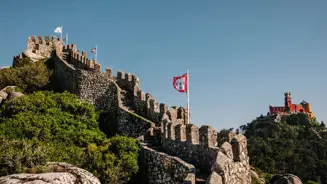The History of the Moorish Castle

A privileged vantage point looking out over the Atlantic coastline, the floodplain and the Sintra Hills, the millennium-old Moorish Castle, founded under Islamic rule, occupied a then strategic position for defending both the surrounding territory and the maritime access routes to the city of Lisbon. The artefacts found on this site identify how, in between the walls and their adjoining areas, there lived a population in an area now named the Islamic Quarter.
The silos, structures carved into the rocks, may be encountered both inside and outside the fortification and were used to conserve certain foodstuffs such as cereals.
The Moors lived here through to 1147, when Sintra was handed over to Afonso Henriques, the first King of Portugal, following the conquest of the cities of Lisbon and Santarém. Strategically and as a means of defending these lands, the running of the town of Sintra and its immediate hinterlands was bestowed on Gualdim Pais, a master in the Knights Templar, who received a charter in 1154.
With the settlement of a Christian population in the Moorish Castle, the Islamic Quarter began to disappear and give way to a Medieval town with its occupation ongoing through to the 15th century. At that time, the site was steadily subject to abandonment given that, with the conflicts between the Moors and Christians long over, the population no longer felt the need to seek shelter within the vicinity of the fortification. This Medieval town included the Church of São Pedro de Canaferrim, built between the two rings of walls.
Already into the 19th century, and in keeping with the Romantic spirit prevailing in that period, King Ferdinand II undertook restoration work on the castle, breathing new life into the medieval imaginary surrounding this site. These renovation works damaged part of the Christian burial grounds of the Church and, for this reason, the order was given to build a tomb to house the bones found there. Given the inability to distinguish whether these were Christian or Moorish human remains, the tomb bears the inscription: “What man brought together, only God may separate”.
The castle has been undergoing archaeological excavation ever since 1976 and has returned countless discoveries as regards the history of this site and its many inhabitants.
In 1995, UNESCO classified the Sintra Cultural Landscape as World Heritage with the Moorish Castle representing a fundamental component.
In 2000, Parques de Sintra took over the management of this national monument. Henceforth, a series of refurbishment and improvement works have taken place, including the 2009 establishment of an Archaeological Research Field in order to deepen and convey knowledge about the human occupations of the castle, its phases of construction and living quarters. Today, the Historical Interpretation Centre of the Moorish Castle, installed in the Church of São Pedro de Canaferrim, tells the stories of this succession of overlapping peoples that lived here, from the Neolithic period through to the Middle Ages, through the archaeological finds and a wide range of interactive tools.
